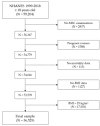Complementary Role of BMI and EOSS in Predicting All-Cause and Cause-Specific Mortality in People with Overweight and Obesity
- PMID: 39458429
- PMCID: PMC11510653
- DOI: 10.3390/nu16203433
Complementary Role of BMI and EOSS in Predicting All-Cause and Cause-Specific Mortality in People with Overweight and Obesity
Abstract
Objective: To assess the complementary role of the Body Mass Index (BMI) and Edmonton Obesity Staging System (EOSS) in predicting all-cause and cause-specific mortality in people living with overweight and obesity (PLwOW/O).
Methods: A longitudinal analysis of prospectively collected data from the 1999-2018 cycles of the National Health and Nutrition Examination Survey (NHANES) was conducted. The association between BMI, EOSS, and mortality was evaluated through Cox regression models, adjusted for confounders.
Results: The analysis included 36,529 subjects; 5329 deaths occurred over a median follow-up of 9.1 years (range: 0-20.8). An increased mortality risk was observed for obesity class II and III (HR = 1.21, 95% CI 1.08-1.36, p = 0.001 and HR = 1.58, 95% CI 1.39-1.80, p < 0.001; compared to overweight), and for EOSS stage 2 and 3 (HR = 1.36, 95% CI 1.16-1.58, p < 0.001 and HR = 2.66, 95% CI 2.26-3.14, p < 0.001; compared to stage 0/1). The prognostic role of BMI was more pronounced in younger patients, males, and non-Black individuals, while that of EOSS was stronger in women. Both BMI and EOSS independently predicted cardiovascular- and diabetes-related mortality. EOSS stage 3 was the only predictor of death from malignancy or renal causes.
Conclusions: BMI and EOSS independently predict all-cause and cause-specific mortality in PLwOW/O. Their integrated use seems advisable to best define the obesity-related mortality risk.
Keywords: EOSS; body mass index; mortality; obesity.
Conflict of interest statement
The authors declare no conflicts of interest.
Figures
Similar articles
-
The utility of the Edmonton Obesity Staging System for the prediction of COVID-19 outcomes: a multi-centre study.Int J Obes (Lond). 2022 Mar;46(3):661-668. doi: 10.1038/s41366-021-01017-8. Epub 2022 Jan 1. Int J Obes (Lond). 2022. PMID: 34974543 Free PMC article.
-
Association between long-term weight loss and obesity-related complications defined by Edmonton obesity staging system: analysis from the NHANES (2011-2018).Eur J Clin Nutr. 2024 Jan;78(1):43-47. doi: 10.1038/s41430-023-01342-3. Epub 2023 Sep 15. Eur J Clin Nutr. 2024. PMID: 37715006
-
Predicting COVID-19 outcomes with the Edmonton Obesity Staging System.Ann Saudi Med. 2024 Mar-Apr;44(2):116-125. doi: 10.5144/0256-4947.2024.116. Epub 2024 Apr 4. Ann Saudi Med. 2024. PMID: 38615185 Free PMC article.
-
The importance of the Edmonton Obesity Staging System in predicting postoperative outcome and 30-day mortality after metabolic surgery.Surg Obes Relat Dis. 2016 Dec;12(10):1847-1855. doi: 10.1016/j.soard.2016.02.042. Epub 2016 Mar 2. Surg Obes Relat Dis. 2016. PMID: 27317606
-
Usefulness of the Edmonton Obesity Staging System for stratifying the presence and severity of weight-related health problems in clinical and community settings: A rapid review of observational studies.Obes Rev. 2020 Nov;21(11):e13120. doi: 10.1111/obr.13120. Epub 2020 Aug 19. Obes Rev. 2020. PMID: 32812345 Review.
Cited by
-
Association of lipid accumulation product with mortality in patients with diabetes mellitus.Sci Rep. 2025 Jul 1;15(1):22006. doi: 10.1038/s41598-025-04861-0. Sci Rep. 2025. PMID: 40594274 Free PMC article.
-
Oral semaglutide for the treatment of obesity: a retrospective real-world study.Front Endocrinol (Lausanne). 2025 May 29;16:1593334. doi: 10.3389/fendo.2025.1593334. eCollection 2025. Front Endocrinol (Lausanne). 2025. PMID: 40510489 Free PMC article.
References
-
- World Health Organization (WHO) Obesity and Overweight. [(accessed on 20 May 2024)]. Available online: https://www.who.int/news-room/fact-sheets/detail/obesity-and-overweight.
-
- Neri D., Steele E.M., Khandpur N., Cediel G., Zapata M.E., Rauber F., Marrón-Ponce J.A., Machado P., da Costa Louzada M.L., Andrade G.C., et al. NOVA Multi-Country Study Group on Ultra-Processed Foods, Diet Quality and Human Health. Ultraprocessed food consumption and dietary nutrient profiles associated with obesity: A multicountry study of children and adolescents. Obes. Rev. 2022;23((Suppl. S1)):e13387. doi: 10.1111/obr.13387. - DOI - PubMed
-
- Williams J., Buoncristiano M., Nardone P., Rito A.I., Spinelli A., Hejgaard T., Kierkegaard L., Nurk E., Kunešová M., Musić Milanović S., et al. A Snapshot of European Children’s Eating Habits: Results from the Fourth Round of the WHO European Childhood Obesity Surveillance Initiative (COSI) Nutrients. 2020;12:2481. doi: 10.3390/nu12082481. - DOI - PMC - PubMed
MeSH terms
LinkOut - more resources
Full Text Sources
Medical


